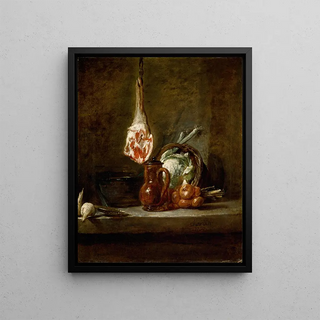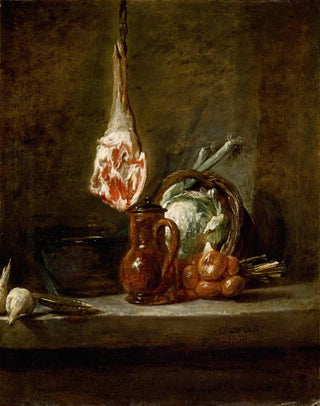Art print | Still life with a leg of lamb - Jean Siméon Chardin Source: Reproduction | Nature morte au gigot d'agneau - Jean Siméon Chardin


View from behind

Frame (optional)
In the world of painting, some works transcend their era and continue to fascinate entire generations. "Nature morte au gigot d'agneau" by Jean Siméon Chardin is a perfect example. This canvas, created in the 18th century, is an ode to simplicity and the beauty of everyday objects. Through this artwork, Chardin immerses us in a universe where the art print becomes a true tableau of life, revealing the richness of textures and colors. Observing this piece, the viewer is invited to contemplate not only the harmonious composition of the elements but also to reflect on the relationship between man and nature, a theme dear to the artist.
Style and uniqueness of the work
Chardin, an undisputed master of the art print, manages to capture the very essence of the objects he depicts. In "Nature morte au gigot d'agneau," light plays a crucial role, illuminating the leg of lamb with a softness that highlights its shades of color. The way he arranges the elements – a pewter plate, fresh vegetables, and the leg of lamb – demonstrates exceptional mastery of composition. Each object, carefully chosen, interacts with the others, creating a visual harmony that captivates the eye. The meticulous details, such as reflections on the metal or the texture of the meat, reveal striking realism, while inviting the viewer to meditative contemplation. Chardin does not merely depict food; he elevates the everyday to the rank of art, transforming ordinary objects into symbols of beauty and life.
The artist and his influence
Jean Siméon Chardin, born in 1699, is often regarded as one of the pioneers of modern art print. His innovative approach marked a turning point in art history, influencing generations of artists. At a time when the baroque dominated, Chardin broke free from conventions to explore more intimate and down-to-earth themes. His work paved the way for movements such as realism and impressionism, where faithful representation of light and textures is paramount. The artists who followed in his footsteps

Matte finish

View from behind

Frame (optional)
In the world of painting, some works transcend their era and continue to fascinate entire generations. "Nature morte au gigot d'agneau" by Jean Siméon Chardin is a perfect example. This canvas, created in the 18th century, is an ode to simplicity and the beauty of everyday objects. Through this artwork, Chardin immerses us in a universe where the art print becomes a true tableau of life, revealing the richness of textures and colors. Observing this piece, the viewer is invited to contemplate not only the harmonious composition of the elements but also to reflect on the relationship between man and nature, a theme dear to the artist.
Style and uniqueness of the work
Chardin, an undisputed master of the art print, manages to capture the very essence of the objects he depicts. In "Nature morte au gigot d'agneau," light plays a crucial role, illuminating the leg of lamb with a softness that highlights its shades of color. The way he arranges the elements – a pewter plate, fresh vegetables, and the leg of lamb – demonstrates exceptional mastery of composition. Each object, carefully chosen, interacts with the others, creating a visual harmony that captivates the eye. The meticulous details, such as reflections on the metal or the texture of the meat, reveal striking realism, while inviting the viewer to meditative contemplation. Chardin does not merely depict food; he elevates the everyday to the rank of art, transforming ordinary objects into symbols of beauty and life.
The artist and his influence
Jean Siméon Chardin, born in 1699, is often regarded as one of the pioneers of modern art print. His innovative approach marked a turning point in art history, influencing generations of artists. At a time when the baroque dominated, Chardin broke free from conventions to explore more intimate and down-to-earth themes. His work paved the way for movements such as realism and impressionism, where faithful representation of light and textures is paramount. The artists who followed in his footsteps






